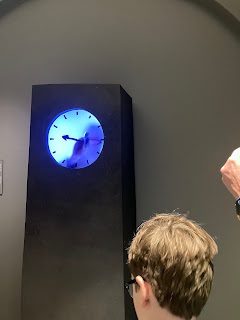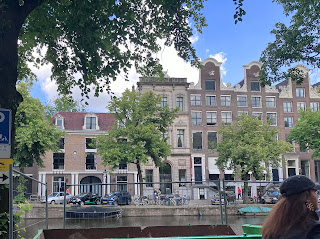June 17th. Again a beautiful fine day.
Breakfast at 7:30 was a surprise. A full buffet with four varieties of Granola to choose from as well as a plain muesli. I had a pleasant and satisfying meal to start my day.
We met for the coach at 8:15 after waiting for the usual one person running late. When she arrived I noted that she had high wedge lace up sandals on her feet and I wondered how she’d survive the day since we had been warned that we would be walking a lot. Eventually we departed through busy morning traffic for the Rijks Museum. So many cyclists. Not just people going to work or children off to school but mothers and fathers with smaller babies and toddlers cycling off to daycares. The view from the bus showed me how well the bus and cycle lanes interact even if at times it all seems a little scary. Not sure I would manage to either cycle or drive in this city but it is certainly a well choreographed ballet.
Once the coach had parked we all needed to cross a busy intersection and meet our local guides for the tour of the museum. It was here that one of the party almost met with an accident and was roundly berated by a cyclist who with some effort had kept his balance.
Our local guide took us through the entry which was a huge arch/tunnel where two lanes of cyclists blithely and speedily passed through the large tour groups waiting to enter. At the base of the steps, under the clear light of the atrium I left my back pack in a locker and we proceeded past a smartly attired gentleman who demanded that one of the group put his water bottle in his pocket. Apparently they are OK if they are not held in hand! One of the group asked why and was told it was to prevent acid attacks.
We were introduced to an amazing clock where it appears that a man hidden inside draws the minute hand each and every minute before erasing it to draw the next. This is the work of Maarten Baas and is certainly highly intriguing.
The first area we saw was a large room of restored painted panels and a beautiful mosaic floor. The guide told us this had previously been covered in whitewash and wooden flooring and it was only now post restoration that the beauty was able to be seen. From here we entered a room with Van Gogh paintings. One small one of Amsterdam had an interesting story of how Vincent painted it quickly while waiting for his friend so they could attend the opening of the Rijks Museum in 1885. His friend came a little early and he pushed the painting into his pocket or his bag and so there are visible smudges and a thumbprint.
Then we went to the “pride and joy” of the 17th century Dutch Masters and our knowledgeable guide gave us much background information and art appreciation tips as we viewed the collection.
In the middle at the right hand side was Rembrandt’s ‘The Night Watch’. It is large and the story is that at one point in history it was to be hung in some civic chambers but wouldn’t fit the space, so instead of finding somewhere else to hang the painting they simply removed around 20% of it. So what we see today, although large, is considerably smaller than the original.
At the far end of the room was a high wall painted with words only and the guide explained that behind there is being constructed a glass room in which restorers and conservators will work in public view doing the work on The Night Watch. It seemed as if in every corner there were discreet smartly dressed security men watching the many tourists who came, gazed, photographed and moved on.
Next we walked over some fancy bridges and along streets beside canals to reach the Museum Van Loon
This former canal house is now open to the public to view what the life of the fabulously wealthy was like in the 17th century, From what I gather the initial income came by marriage with a wealthy trader of the Dutch East Indies Company whose wife continued his business when he died. She had financial dealings with the King and from that increased both prestige and wealth. Her granddaughter married a Van Loon and so established the dynasty.
A narrow canal house there is an imposing door with steps up leading to an imposing lobby. Beside the door is a smaller, less conspicuous one with steeper stairs which leads up to the attic floor where the servants lived. Nowadays the only living descendants of the Van Loons lives there with her family. She is an artist and now in the 21st century is rather embarrassed at the source of her families wealth so curates art exhibitions to try and bring some sense to the history of colonialism and the Golden Age of The Netherlands. Behind the house separating the main house from the coach house was a large garden set out in the French style, box hedges and rose bushes. The coach house is built in such a way that the horses can be stabled and the coaches driven straight out onto the street, so connecting canal and street.
Following this we were walked to Rembrandt Square where we had time to find lunch. I walked down a small street and saw a sign labelled Coffee Shop which seemed promising until I drew closer and looked in to see men of a variety of ethnicities hunched over small tables smoking joints. Uh huh. Not for me! I promptly turned around, walked the other way and went to Starbucks! Safer, lighter, less smelly and certainly more nutritious.
After lunch we met up for an excursion to Muiderslot Castle. Starting with a 30 minute drive out of the main city we arrived to a picturesque village. It was one of the defence castles built in the late 1200s and from it tolls used to be exacted on traders who used the river. Since then it has gone through several iterations and in the 1600s it was the place where gatherings of poets, musicians, writers used to take place. Now it is preserved as a museum and is obviously visited by many people.
There was a beautifully laid out and productive garden to the left of the entrance way and the castle itself was small and surrounded by a moat so we had to cross a drawbridge.
Outside the castle were artistic installations of ‘far greater than lifesize’ insects
This village seems to be on a mission to educate the younger generation on climate change, environment protection etc. If I understood the guide’s commentary correctly this partly has its roots in a guilt over the damming of the Zuiderzee and the consequent imbalance of the ecology created by that.
We all walked back through the fishing village to The Fort - a small but elegant restaurant near where the coach was waiting. Here we had a cool drink and tasted Bitterballen. Our guide explained to us that this was created many years ago as an economical way of using up left over scraps of meat. That may well be so but those we were served had little meat in them. I’m not sure they will make it on to my list of favourite foods :)
The landscape was so satisfyingly Dutch pastoral.
Back to the hotel for a half hour break and then on to another excursion to Monnickendam. This fishing village gets a prize for cuteness. Narrow streets meant that the coach could not get close and so we parked and walked the cobbled streets down to The Weigh Station for our evening meal.
The soft sandy peaty soil and the use of wooden piling in times past has created problems with rotting foundations and consequently leaning buildings. St Nicholas church here had a distinct leaning section at the back - both sideways and outwards. I’m assuming that this has been stabilised, but then perhaps not.
The gable stones of the houses used to signify addresses in the old times. It was Napoleon who insisted on surnames for the people and at the same time numbers for the houses and names for the streets but the decorative gables are still a feature of the older Dutch houses.
One house had a decorative plaque of the Monnickendam Coat of Arms. Two eagles, and a Monk carrying what some think is a mace; some think it merely a staff; others say it is a weapon. Exactly what it is seems to be lost in the mists of time but there were several iterations throughout the village.
At one time Monnickendam had been quite a trading port and The Weigh House had served a function similar to a Customs House where goods were weighed and accurately tallied.
In the ceiling it was possible to see some of the ancient hoists that had been used. We had a delicious meal of generous proportions and so having forgotten what I’d selected for the dessert when we’d filled out the form in the morning I elected to skip dessert altogether. Probably a very good thing as although I walked around 15000 steps today it wasn’t at an exercise pace!
We walked back to the coach on a different route. This sure is a quaint little village.
We arrived back at the hotel at just after 10pm and the sun was only just then setting. Days sure are long here in the summer.





















































2 comments:
Another amazing day discovering new things and lots of history. We had a holiday in Holland when the kids were younger but not near Amsterdam
Wow, that sounds like a long and exhausting, but also very interesting day! I think I am most amused by that amazing clock...just imagine if that really was your job, sitting in there and drawing an errasing the hands!
Post a Comment